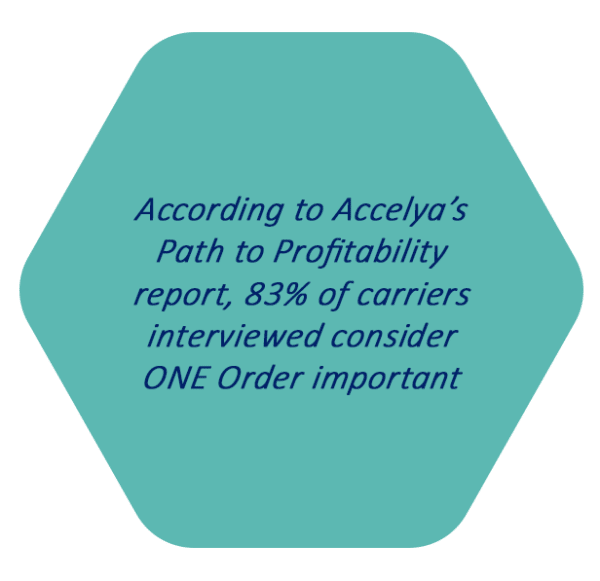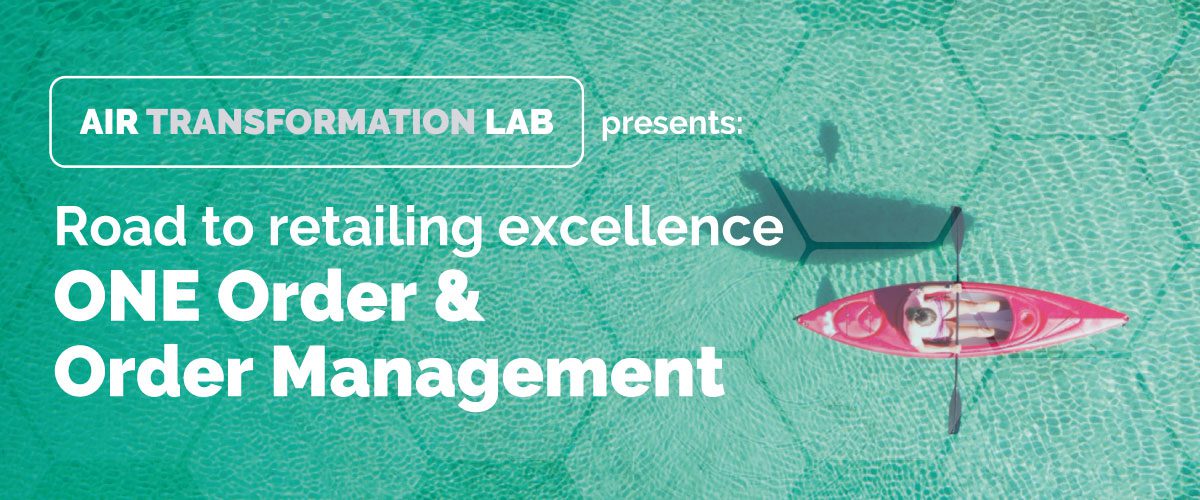Do you need to get up to speed with ONE Order or do you want a refresher? Curious about how it will affect the future of the airline business? Then, read on for an introduction to ONE Order and order management. Also, keep an eye out for more articles in this new chapter of the Air Transformation Lab that deep dive into the various entry points and aspects that make up an airline’s retailing transformation journey.
Introduction
In 2012, airline retailing entered a period of transformation when IATA introduced its New Distribution Capability (NDC) program. NDC promised to give airlines more control over creating offers and the freedom to distribute them, notably in their indirect (agency) channels.
Although it gained traction relatively slowly, NDC adoption has gathered pace. In fact, 2021 was the year NDC finally went ‘mainstream’. We saw a 73% increase in the number of tickets sold through NDC channels – which are processed via the Accelya FLX Platform – compared to the equivalent pre-pandemic period in 2019. For some of our customers, the volume of NDC transactions is on par with those processed via their GDS channels.
Why do we begin an article on ONE Order with NDC? Well, think of NDC as the ignition for the much-needed transformation of airline commerce and ONE Order as the jet fuel that will propel the journey forward to help – well, just about everyone. NDC, offer management, and ONE Order are ‘sister’ technology solutions that enable us to break free from legacy constraints and put airlines in control of retailing.
ONE Order as a concept is not new. However, a number of airlines are still figuring out what it means for them. Also, the COVID-19 disruption has set many airlines back in resourcing change, so ONE Order adoption is not on the near-term strategy horizon for everyone. Although, the industry predominantly agrees on its significance.
With that said, several airline frontrunners and technology partners are preparing to take the next transformational leap. It’s interesting to see European airlines, like Finnair and Lufthansa Group, currently leading the way! At the time of writing, 31 players already feature in the IATA ONE Order certification registry. Airlines and their technology partners have conducted over ten ONE Order pilots, covering interlining and revenue accounting. Plus, we are seeing more RFPs mention ONE Order and order management. Some of them are specific to ONE Order, and others make sure vendors are ONE Order compliant.
Without further ado, let’s take a closer look at ONE Order and order management, and where we are in the industry.
ONE Order and Order Management
Why? ONE Order’s Retailing Excellence
Every good retailer knows their customers – they can create offers for their customers, then sell, distribute, manage, and fulfill them. But the current technology framework makes having such a relationship very difficult for airlines. One of the reasons is that after customers buy, current systems generate multiple data record types, such as PNRs, eTickets, and EMDs. These different records make it hard for airlines to understand what a customer has bought and what has changed as they move along the travel and retailing experience.
ONE Order enables airlines to put customers first by phasing out different record types in favor of a hotel-inspired folio-like approach to document the passengers’ purchases. In ONE Order, we call this folio a ‘single order record’ or simply ‘the order’ – and it’s created regardless of when or where the transaction occurs.
People (customers or agents) or technology (automation) can make changes to, cancel, or refund the order at any time (aligned with the airline’s rules, of course), and these actions are reflected across all channels in real time. In addition, it enables information to flow freely across the airline business, from offer to settlement, making it easier for the different functions to manage, fulfill and account for the purchases.
With ONE Order comes the opportunity for airlines to take retailing to the next level and enhance the customer experience from inspiration, booking, and servicing, to fulfillment and disruption (IROPs).
ONE Order enables retailing excellence.
When? ONE Order “Gets Real”
IATA introduced the ONE Order program back in 2015. And like NDC, ONE Order was slow to burn, but then in 2021, the drive for transformation heated up. Here’s what happened.
Airline Retailing Maturity Index (ARMi)
Reflecting that transformation is more than NDC and ONE Order, in 2021, IATA introduced the Airline Retailing Maturity index (ARMi) which provides a more robust view on transformation maturity, by including Dynamic Offers, Settlement with Orders (SwO), and the Future of Interline into the maturity equation. Frontrunners, such as Accelya, received certification.
So, what are these aligned programs?
Dynamic Offers – Supports the industry to leverage data about the customer and commercial context to create more relevant, customized offers, made up of fares, ancillaries, or bundles.
Settlement with Orders (SwO) – Maps out how airlines and travel sellers can directly settle transactions using the IATA BSP ‘clearing house’ (middleware). It demonstrates that IATA themselves are gearing up to settle actual orders, not just traditional tickets, and documents! By implementing SwO, airline retailing systems can automatically settle payments with travel sellers if transaction details (orders) meet agreed conditions. This approach means streamlined payment between airlines and their travel seller partners, resulting in better cash flow.
Future of Interlining – Makes it easier for airlines to collaborate to get a customer where they want to fly. Today, if an airline wants to interline with a partner, they need to negotiate a Special Prorate Agreement that sets out how payment will be divided, and that can get very complicated. But with orders and NDC Interline, it will be a lot easier. In the new world, an “offer responsible airline” (ORA) will use orders to align partners around fulfillment and settlement, making interlining a lot more streamlined and potentially, enabling new types of commercial agreements between partners.
From an industry-wide perspective, interline will be a tough nut to crack, as it will require all partners to be equally equipped to handle both offers and orders.
Order Accounting
To prepare Finance operations for the world of retailing, Accelya invested in Order Accounting. This solution enables Finance to account for traditional EMDs, PNRs, and eTickets in addition to orders, until the time that legacy documents are phased out. This hybrid approach enables Finance to transition from today’s world to a future operating environment characterized by orders without disruption to business operations – and helps Finance more easily accommodate innovative offers. We will touch on this again later.

An Industry Call to Action
IATA’s Distribution Advisory Council (DAC) set out an aspirational goal of sunsetting all legacy documents and related processes by 2030. Then, Finnair made an announcement that reverberated far and wide. The airline would “end support for all legacy EDIFACT content across the travel sector by the end of 2025 to drive a major change within the industry”. This transformation would be underpinned by NDC and a move to order management.
From an industry perspective, in 2021, ONE Order ‘got real’.
Benefits – A Deep Dive
We have already touched on some of the benefits of an order-enabled world. In this section, we will take a deeper look, beginning with offer innovation.
Revolutionary Offers
Many airlines find bringing innovative products to market challenging because existing systems and downstream processes, like fulfillment and settlement, don’t have the flexibility to adapt. In fact, this is a major innovation killer for many product ideas!
As order management streamlines the flow of customer and transaction information and makes it more accessible to other systems, it accelerates product innovation.
 In a world characterized by order management, fulfillment, and financial operations will be ready for anything eCommerce, Pricing, and Ancillary Management dream up. But the opportunity doesn’t stop there.
In a world characterized by order management, fulfillment, and financial operations will be ready for anything eCommerce, Pricing, and Ancillary Management dream up. But the opportunity doesn’t stop there.
Better access to customer shopping data will make it easier for airlines to understand their customers, preferences, and intentions. As such, orders will be an important data source for personalized offers. Airlines can use insights within the order to dynamically create fare, ancillary, and bundled offers that better fit the customer’s needs and the commercial context.
What’s more, airlines will be able to work more efficiently with partners outside of the aviation domain, such as car rental companies, hotels, and experiences, to become a ‘one-stop’ travel shop.
For customers, orders and offer innovation means more choice – and for airlines, they speed the path to new revenue.
Data-informed Retailing
The airline industry is awash with data, but we aren’t using it enough. Part of the reason is that legacy records like PNRs and EMDs can be challenging to dissect and aggregate without specialist expertise. As mentioned above, orders will bring down these barriers, improve access to data, and ultimately enable airlines to make better decisions. With real-time insights on performance at each stage of the transaction, from look and book to service and settle, this data will see airlines better support the health of their retailing platforms and supercharge decision-making.
Retailing Across The Customer Journey
Knowing where a customer is in their travel experience, and their purchases will help airlines better meet their needs. For example, with orders, the airport folks will use the same record that reservation folks use. So, why not extend the same retailing capabilities that the reservation and airline.com systems have to the airport staff as well? With many ancillaries sold within the departure window, ONE Order will allow airlines to continue to put their best retailing foot forward throughout the customer lifecycle, including on day of travel, without the challenges we have with legacy systems.
Servicing At Any Touchpoint
Remember those horrific call center queues at the start of the COVID-19 pandemic and every global spike afterward? Well, this situation could be alleviated by customer-centric orders.
 For example:
For example:
- When customers make changes directly with an airline, legacy systems and processes prevent travel agents from accessing purchase data and stop them from servicing bookings. With orders, travel agents can provide even greater value to the customer and the airline. They will be able to open the order and help service it, thereby relieving pressure on reservation and airport staff, especially on the day of operation.
- Order management will facilitate customers managing their own bookings on airline.com and mobile applications regardless of where they bought their ticket.
- Airlines will be able to make global changes to customers’ purchases through automation.
No more waiting for hours on the phone!
Streamlined IT
Many existing processes and tools are built to overcome the barriers imposed by legacy limitations. The elimination of legacy documents will reduce the need for some technology and processes (e.g., ET server, auditing, etc.), so airlines benefit from simplification and lower costs.
Partner Retailing
Customers will be able to enjoy a seamless travel experience regardless of whether they are flying with the retailer airline or its partners (interline, codeshare, alliances).
For example, the ancillaries a customer buys from a ‘retailer’ carrier do not automatically extend across their trip when they board an airline partner (‘supplier’) for a connecting flight. It’s common to see customers spending on the best seats with the retailer airline or fly business class only to be relegated to the middle seat in the middle aisle at the back of the plane when flying on a supplier leg.
This is because customer and purchase information is largely inaccessible, and does not flow freely between airlines – a situation that will improve when airlines enter an order-centric world.
Future-proof Retailing
Change is life’s only constant, and an airline’s operating context is a dynamic landscape. Orders provide the openness and flexibility needed to stay ahead of the curve. A good example is payments. Blockchain, cryptocurrencies, digital wallets – there are many alternatives. With order management, airlines will be more ready to adopt these new forms of payment without a massive technology investment, which is required for traditional systems today.
Industry-wide Innovation

The ‘legacy spaghetti’ of EMD, PNR, eTicket standards create barriers for companies wanting to enter the airline retailing arena. With those barriers flattened, should we be prepared to embrace a new level of innovation from the tech startup community? From our perspective, ONE Order transformation will herald a bold new future for airlines and a vibrant ecosystem of technology partners.
That was a long list of potential benefits. Ultimately, airlines will tap into whatever helps them deliver on their strategy and provide a customer experience that is right for their brand.
How? End-to-End Retailing
Until now we have discussed how ONE Order came about and the benefits it can bring customers and airlines. In this section, we will touch, at a very high level, on some of the technical elements.

1. Order Management System (OMS). The OMS is not a solution invented for the airline industry, it is at the heart of today’s online retailing platforms, such as Shopify and Amazon. It connects the passenger with their purchase at every stage in the retailing and travel experience and automates internal processes.
The OMS integrates with nearly every aspect of the airline business, from the point of sale and inventory to boarding functions and customer service, to ensure customers get what they have bought – a valued travel experience. It provides the link with other technology elements to enable better retailing and as such, is the backbone of a ONE Order solution.
2. Offer Management Systems. Offer Management Systems create and sell priced products (flights, ancillaries, and bundles) and the marriage between offer management and order management is dynastic. By connecting the OMS to Offer Management Systems, once the customer chooses their products, the OMS creates and manages the orders. Importantly, the OMS also connects to the Offer Management Systems to create new offers when required, for example, to request an automated reshop for alternative products, when a change affects the customer.
 3. Customer Relationship Management (CRM). This function is the access point to understanding and servicing the customer. It stores everything about the customer, their retailing history, and current retailing experience.
3. Customer Relationship Management (CRM). This function is the access point to understanding and servicing the customer. It stores everything about the customer, their retailing history, and current retailing experience.
4. Fulfillment: This connection is usually with the passenger service system’s (PSS) departure control system (DCS) which tracks operational actions such as check-in and boarding to monitor fulfillment.
5. Financial Obligations. You can’t sell something if you can’t account for it! So, tight integration with accounting and settlement systems is critical. Retailing needs to extend end-to-end. The OMS passes order information through to downstream functions and enables Finance to better accommodate new products such as dynamically priced flights and innovative ancillaries.
6. Analytics: By sending order information to analytics tools and combining it with sales and financial data, airlines can benefit from insights into retailing performance and identify areas of retailing opportunity, as we have previously explored.
7. Payments: Not only does an order need to connect to a payment provider to complete the sale, but if an offer is refunded, changed, or canceled, then payments certainly come into play.

Conclusion
We hope at this point you will have a good understanding of what ONE Order and order management is and how they came about. As you will have discovered, ONE Order is a fundamental pillar that touches all elements of airline-controlled retailing, so it isn’t a stand-alone solution. It is just one aspect of an airline’s retailing transformation journey that can take many paths, including NDC adoption, Offer Management, Order Accounting, digital experiences, and more.
The good news is that you don’t have to tackle retailing transformation all at once. There are many routes and places to start. Those places can differ depending on your business requirements, strategy, and your own function within the airline business. This is what we will be exploring in this new chapter of the Air Transformation Lab.
Annex
Order Management – What To Look For In A Technology Partner
If you are considering moving to ONE Order, choose your technology partner carefully. Here are some tips to help you get started.
- Look for partners with a technology footprint across the airline business, as they are best positioned to enable end-to-end ONE Order transformation from making offers to accounting operations.
- Work with partners with a track record in airline retailing transformation because every airline’s transformation is unique. Your partner should have the expertise to deliver you to the desired end state no matter your starting point.
- Is your vendor already making inroads with Settlement with Orders (SwO), Order Accounting, is on the IATA ARM index, and participates in the IATA ONE Order working groups? If so, this shows the leadership, commitment, and investment required in taking your airline on the journey ahead.
- Do they have integration expertise? As we discussed, earlier connections are key to unlocking value from ONE Order. Integration expertise will ensure your order management implementation connects with all the necessary players, including partner airlines, operational services, and technology vendors.
- Does your partner have experience taking standards, like NDC and ONE Order, and making them work in the ‘real world’? ONE Order is a standard and standards are fantastic as they point the industry in the same transformational direction. That’s important for collaboration and partnership. But, sometimes, standards can take a while to catch up with today’s business needs. Your partner will need to enable you to comply with standards while supplementing where required, to ensure your ONE Order solution delivers immediate value, from Day One.
- Are they ‘pro-airline’? This journey is about freeing airline retailing from legacy, opening IT to innovation, and providing airlines with more choice. Ensure your chosen partner is also committed to these goals. Remember, past performance is the most accurate predictor of future performance.
If you are interested in this topic and want to learn more, feel free to reach out to us by clicking the button below.

